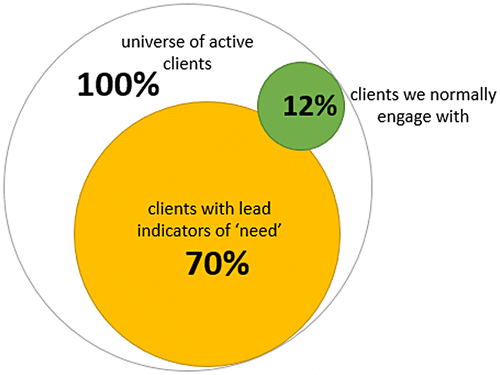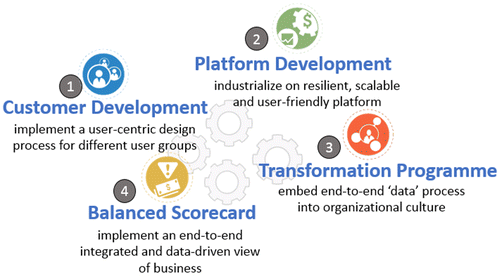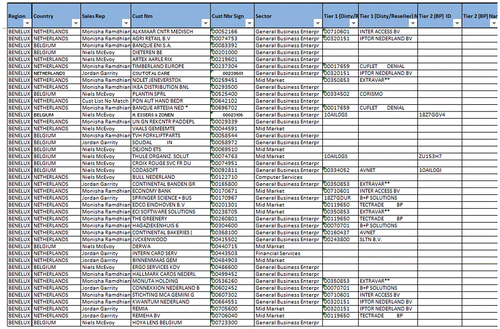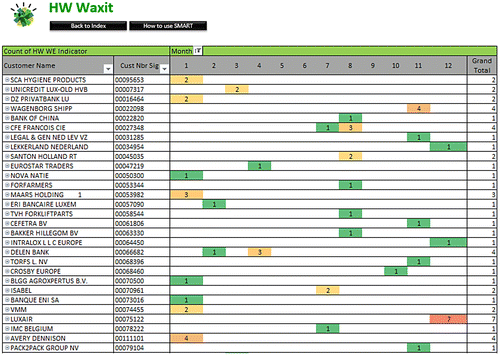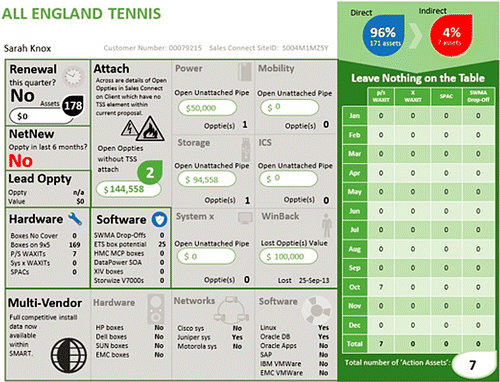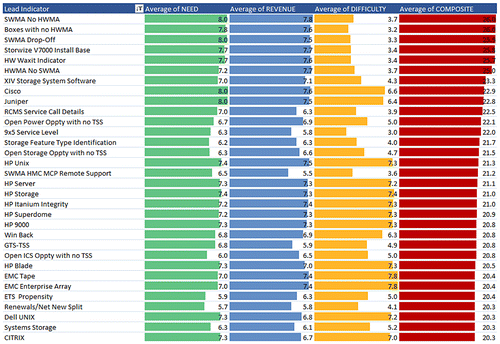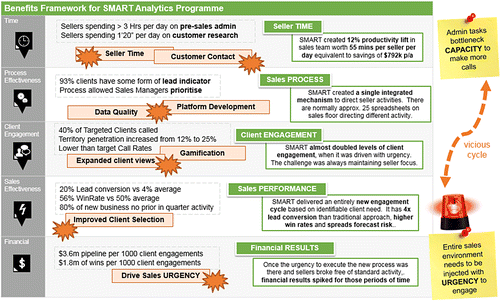Abstract
Data visualization is a key tool to drive both end user adoption and change management activities within data initiatives and especially so in sales environments. Data is as much a part of the problem as the solution itself. There’s too much of it, it’s difficult to interpret and sellers hold on to tactical workload out of distrust in the data systems they are provided with.
A data-driven approach to the sales engagement cycle can fundamentally improve performance. Using an analytical approach to determine client needs and sales ‘signals’, sales engagement can be tuned to be in sync with market needs. However, a range of technical, organisational and cultural issues need to be addressed before such a solution can truly start to deliver results.
A prototype has been developed and implemented within IBM Digital Sales Europe to test the effectiveness of a data-driven approach to territory management. This practitioner focussed paper looks at the impact on business results that the programme used to introduce such new territory management methods had.It uses the 6 wise men approach to consider the nature of the problem and where the initiative directly impacted outcomes. Its answers questions on (1) what was the data driven initiative being implemented, (2) why it was important, (3) how it was implemented, (4) when it took place, (5) who has benefited and (6) where business value was created. This paper concludes that data initiatives require considerable transformation effort to be successful. Moreover, it identifies that there is a broad range of benefits available beyond the immediate territory management effectiveness of a data-driven client selection methodology.
1. What is the data driven initiative being reported?
SMART is a prototype ‘data-centric’ business process aimed at creating a data-driven sales culture within IBM’s Digital Sales Centre for Europe. Specifically, it is an attempt to provide end users in a sales environment with an integrated end-to-end approach for client selection and territory management in such a way as to maximise the return for time spent and revenue results achieved.
Table 1. The SMART Iterations.
The prototype was implemented in a ‘traditional’ sales environment where 60 sellers normally focussed on a part of the IBM services portfolio dominated by the renewal nature of the client engagement cycle.
Analysis to provide the sales team with a broader ‘view’ of known data or insight about clients discovered that there was a mis-match between the clients that the sellers actually engaged and the clients who met criteria that the sellers themselves had advised were ‘leading indicators’ of need – i.e. those clients who have business requirements.
In response, the ‘SMART’ business process was designed to aggregate ‘high value’ client data, integrate it, apply a level of transformation and deliver 2 key artefacts back to the sales teams. The first was a ranking system to indicate high value clients and ‘Next Best Customer’ selections and the second was 360-degree view of each customer – the so-called SMART ‘Client-On-A-Page’ to aid with data delivery and end user interpretation, engagement and process adoption.
The process was implemented and altered over 4 iterations as user feedback was brought incorporated and process and business transformation considerations removed obstacles from yielding improved results.
Final results bore out that while salespeople can benefit greatly from a data-driven approach to client engagement, there are often broader organisational or systemic roadblocks preventing deeper ongoing adoption. In fact, a key finding was that a data-driven process alone will struggle to gain traction unless there is a data driven culture within the organisation.
2. Why is it an important initiative?
The data-driven client engagement is important for three key reasons:
| • | It aims to improve CLIENT ENGAGEMENT | ||||
Current practice within the chosen business unit is to ‘engage’ the client based on what business logic advocated was most urgent – namely a contract ‘renewal event’. Client engagement rules are predicated on a very small number of criteria – contract renewal, contract size, instal inventory type etc.
However, this logic once applied means that only 3% of total ‘active’ clients are prioritised for engagement in any given sales quarter, 12% annually, leaving the majority of clients without an effective ongoing ‘relationship’ with IBM.
The SMART process identifies clients with ‘needs’ outside the IBM-centric ones around renewals and moves towards a client-centric definition of what’s ‘important’ – i.e. their needs instead of their vendor’s. In practice, this resulted in the identification of an average 70% of clients within sales territories with lead indicators of need. Furthermore, 80% of those do not have a renewal event – we wouldn’t ordinarily be engaging with them.
| • | It aims to INCREASE SALES RESULTS | ||||
The analysis undertaken indicates existing client engagement model has suppressed sales results due to a lack of breadth and depth of engagement. By creating a ‘secondary’ engagement cycle, interacting with more clients and developing more sales opportunities the approach drives incremental results accordingly.
In addition, in doing so, the process also reduces risk in sales forecasting as it broadens the sales pipeline and reduces reliance on a small number of large cyclical and often price-sensitive deals.
| • | It aims to reduce sales PROCESS INEFFICIENCIES | ||||
The prototype discovered that the main class of inhibitor to the adoption of data-driven practices were the inefficiencies created by incumbent ‘legacy’ data practices. These were shown to be inefficient, time intensive, created multiple versions of the truth which in turn led to a series of problems from ineffective decisions to a pattern of ‘over-deliberating’ when it came to client research and engagement.
3. How was the initiative implemented?
‘SMART’ was implemented using an Action Design Research methodology across four framework pillars through four iterations over a 35-month timeframe from April 2012 to February 2015
3.1. Transformation pillars
| (1) | Customer/Stakeholder Development: a user-centric design thinking process for different user groups | ||||
| (2) | Platform Development: use of agile to drive technical development on resilient and scalable platform | ||||
| (3) | Transformation Programme: embed an end-to-end data driven approach within organisational culture | ||||
| (4) | Balanced Scorecard: use of in-depth performance analysis to measure effectiveness impact on business | ||||
As lessons were learnt from each ‘iteration they were analysed to identify any underlying root cause issues inhibiting results with alterations made for subsequent iterations. Each iteration grew organically from the previous and while not designed as such, the iterations did have broad ‘themes’ to developments undertaken:
3.1.1. Iteration 1: data aggregation
Simple data aggregation across multiple databases and systems of record was delivered back to sellers with minimal transformation and no ‘next best customer’ modelling. Data was provided as-is within Excel.
3.1.2. Iteration 2: data simplification and process design
‘Views’ were created in the SMART ‘reports’ to match user-defined use-cases data to make the ‘patterns’ more accessible to sellers who weren’t naturally analytic. We also created a process to drive a planned approach to territory management and made first attempts at flagging clients with higher potential for sales.
3.1.3. Iteration 3: data visualisation and process simplification
A new artefact was introduced – the Client-On-A-Page - which was a visual representation of the same data as previously available in datasheets but now in an infographic-style - a 360-degree view of the client based on all available known data. Integration of the artefact and process within the Opportunity Management (CRM) system is also implemented.
3.1.4. Iteration 4: SME-led analytic modelling and activity ring-fencing
A new analytical model based on encoding end-user SME sales expertise is designed to mitigate against the limitations of availability and lack of breadth of historic data to identify client selection. The Client-On-A-Page artefact is migrated to a hi-fidelity enterprise platform providing scale and a ‘data-driven’ productivity programme creates extra time for sellers to engage more effectively in the process.
4. When did this initiative take place?
The programme has run through 4 iteration cycles from April 2012 until the end of 2015
5. Who has benefited from the initiative?
While the initial work was intended almost exclusively for the benefit of the individual sellers there are in fact 5 distinct groups who benefit from the work undertaken:
5.1. Sellers
Sellers now have a completely end-to-end, web based and CRM integrated process to analyse their overall sales territory for patterns of client needs and to drill down at individual client level and examine specific lead indicators of need in preparation for customer engagement.
5.2. Customers
The previous engagement process was vendor-centric in that clients were engaged predominantly when IBM needed them to – to sign the contract renewal. Defining a new engagement process around data-led indicators of client ‘pain points’ both increased the breadth and depth of clients being considered but also re-aligns the timeliness of engagement towards customer needs more so than the vendor-centric approach.
5.3. Management
The SMART process provides a level of transparency over seller activity that was previously unavailable. Normally sales cadences and reviews focus on ‘pipeline’ management – what opportunities are already in scope and not territory management – what should be in scope. Managers are thus better able to evaluate the trade-offs in decisions sellers are making on where and how to spend their limited time.
5.4. Marketing
Until now marketing has been almost universally a top-down approach where a ‘Brand’ marketing team will identify a particular product, provide seller training and enablement of some collateral and then hand over to sellers to prospect. Client selection at best is based on one or two high level criteria based on historic data and specific to a particular ‘offering’ or ‘product’ – e.g. a customer has bought X in the past.
The SMART process allows for a much more effective triage of clients from the bottom up. By looking at everything the organisation can determine about a client across multiple data sets we build a more holistic view of both customers and markets. We also critically see the marketing strategy from the bottom up as opposed to the top down – what problems our customers have, not what do we want to sell them, which improves marketing segmentation and alignment between offerings and client groups.
5.5. Digital sales organisation
Digital Sales has benefited in two main ways – by creating a framework that can be applied elsewhere within the organisation and by improving seller productivity. The approach has now been expanded to cover four other sales teams from hardware to consultancy sales and tackling problems from early stage lead development to improving territory triage effectiveness.
In addition, the process has both uncovered and addressed issues regarding substantial seller productivity bottlenecks in the area of customer research, information management and general data related tasks that eat up seller time.
6. Where is the business value being realised from this initiative?
The business value accruing to the initiative falls into 5 categories:
6.1. Time
Prior to the initiative sellers were spending more than 3 h a day on pre-sales administration related activities and 1 h 20 min of that relates to customer research. The SMART body of work has gained back 50 min per seller per day equivalent to a 10% productivity gain on a standard 8 h working day. Furthermore, by enabling data-intensive work to be done we are enabling the sellers to reach clients earlier in the engagement cycle. Previously, clients with renewals were engaged with 18 days in advance of a renewal event whereas now we are able to complete all data work for a seller 78 days in advance allowing clients to be engaged with months earlier.
6.2. Process effectiveness
Pre-SMART sellers had to interrogate a range of dispersed data sources and tools – 38 in total – which had the impact of eating up time as well as impeding the quality of decisions made. When data was dispersed, sellers tended to evaluate the most easily available information, renewals data, without considering the full breadth of facts relating to a client. SMART now provides a common, standardised and scalable ‘single version of the truth’ that both simplifies the working environment and provides more complete insight to make decisions.
6.3. Client engagement
We now have two engagement cycles and not just one focussed on renewal events. Sellers are now targeted with making 10 client engagements per week using the methodology. Over the course of a full quarter, over 80% of these engagements will now be non-renewal event related which represents a fundamental shift in seller behaviour regarding end customer interaction. That said, sellers have struggled to meet these call volumes with maximum 30% of the target being met on an ongoing basis, even with productivity gains aforementioned, which raises a new set of questions around roadblock and seller behaviour.
6.4. Sales effectiveness
Where SMART was used, the conversion rate of client calls to opportunities (Conversion Rate) was 20% which compares with an average of 4% for similar lead development activities within IBM. Furthermore, once progressed a SMART Opportunity has a slightly higher Win Rate (56% vs. 50%) compared to standard leads and a slightly higher average value ($23 k vs. $21 k) compared to business as usual new business deals. This suggests that, while the progression metrics are as good or better than standard, it’s the lead conversion rates that make the biggest difference. What is also significant is that 72% of the new business created was on customers who did not have a renewal within the period. That is, if SMART had not pre-empted engagement the seller would not have ‘normally’ called the customer.
6.5. Financial
Overall SMART has contributed $10 m of sales opportunity that would not otherwise have existed over the course of the prototype. To contextualise, a contribution of $6.9 m in Net New business pipeline in 4Q 2015 with $1.6 m Won deals within the period represented approximately 9% of the new business sales target for the quarter in question. While healthy in itself as a contribution the most significant observation is the potential value that exists if we are able to increase the volume of client calls made by each seller given that they continue to be low. If sellers are enabled to meet the targets set by management, and with the conversion and win rates evidenced so far, the financial impact should be of the order of 3800 client engagements, 760 new sales opportunities and $17 m in pipeline. Work is now firmly focussed on a range of initiatives to increase call volumes.
Disclosure statement
No potential conflict of interest was reported by the author.

